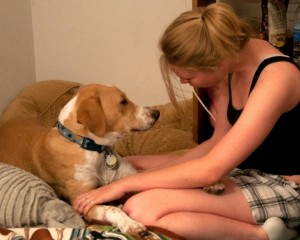Michael Baugh CPDT-KA, CDBC
I get to see Tad again tomorrow, and the anticipation has had me thinking about the brilliant truth of teaching and learning.
Given the right set of circumstances, a learner will tend toward making the right decision. Scientifically that means if we set up the environment correctly our student will succeed. That includes both environmental cues and pleasant consequences for the learner. So much for the nerdy part. Here’s the softer part. All of my students really are working toward success; it’s the natural tendency of progress.

There isn’t anything inside Tad that predestines him to behave poorly. There’s no internal badness in dogs that we humans have to break or dominate. Dogs, like all other learners are naturally (meaning it’s in their nature) built to discover the easiest right choices for behavior, and to act on them. In fact, even “bad” behavior is at the time the perceived right choice for the dog. Our job as teachers is simply to clear the path, make the choices we prefer more obvious, and reinforce those correct choices joyfully. That’s teaching.
I always trust my client dogs to find and make the right choice. If they don’t, I look at myself first to make adjustments. I never look inside the dog for sinister intentions with flimsy labels like stubbornness or jealousy. What can I change in this student’s environment to make it easier for him to make a correct behavior choice? When he makes that correct choice, how can I tell him he got it right so that he makes that choice again in the future? I joke that dog teaching isn’t a religion it’s a science. Still, it takes a whole lot of faith to ask those questions, trust the dog, and trust the process.
I smile every time I remember that humans can be trusted too. When we talk about a learner’s environment, we’re really talking about relationships. A supportive, empathetic relationship between a teacher and a learner (and really we’re all co-learners) sets the client up to succeed, every time, without exception. I nod respectfully to the late Carl Rogers who brought this knowledge to us. Humans are naturally built (meaning it’s in their nature) to ascend to the highest level of success possible, given the right environment and relationships. Abraham Maslow called that “self actualization,” and all of us are on the path. My path as a teacher and a learner fills me with faith every day. I trust the people I teach, and the dogs they teach in turn. I learn from them too. Certainly, it’s not always easy. Tiffany will tell you that, as will Tad in his own way. Still, we travel on together, clearing the path for our better selves, applying the science with abiding faith.


